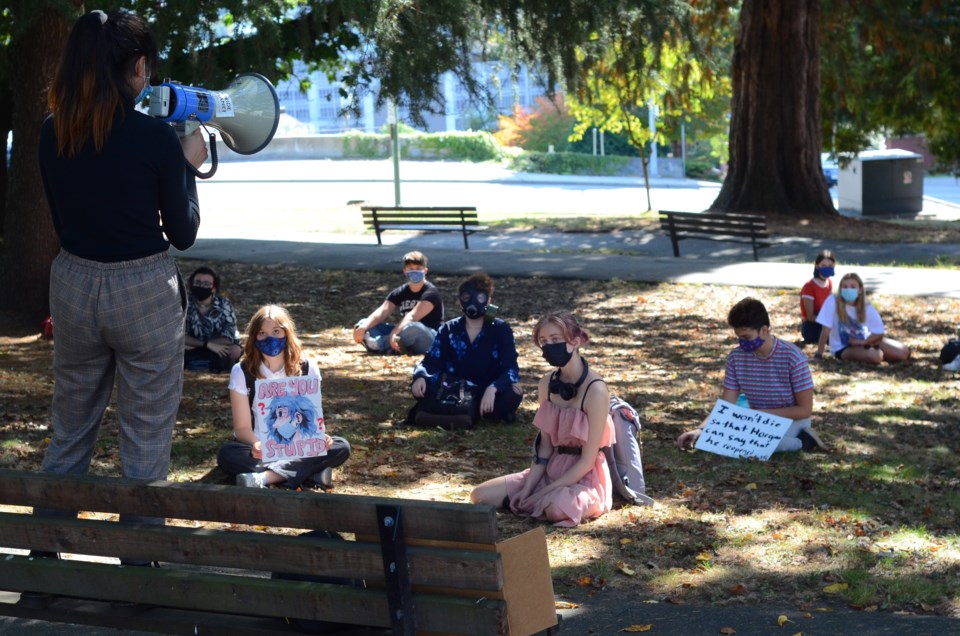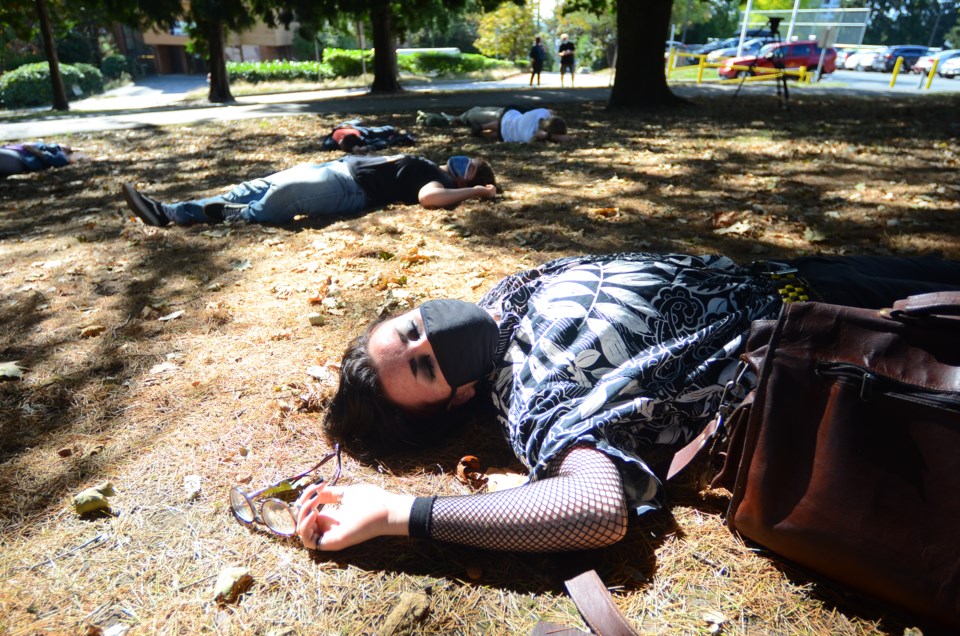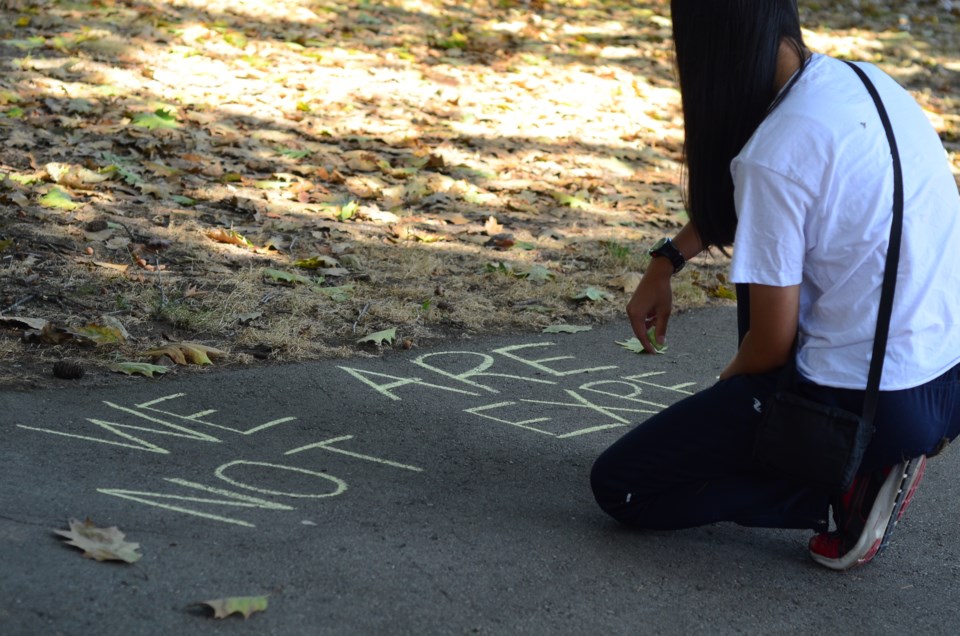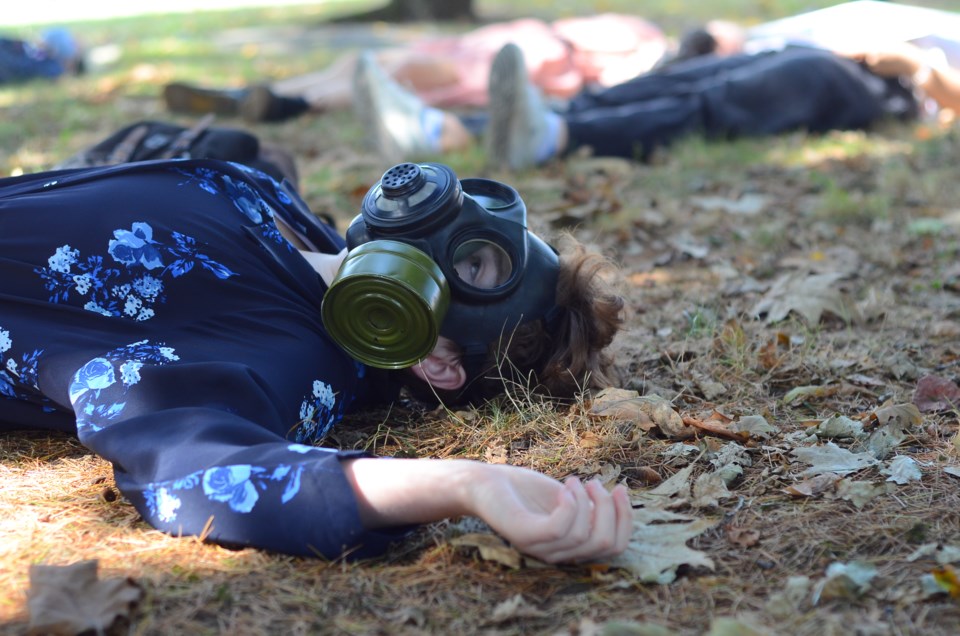It’s a stark, cold, sobering image: a group of teenagers lying dead on the lawn.
A group of New Westminster Secondary School students hopes that visual helps them to drive home their concerns over COVID-19 and how it’s being handled in schools.
The students staged a class walkout today and marched – in masked, socially distanced small groups – down to the school district administration office to make their case that schools need better pandemic planning in place.

The protest at the district office included speakers and a staged “die-in,” with students taking turns pretending to be dead “to kind of illustrate the consequences of what might happen if more strict safety protocols aren’t developed,” as student organizer Elena Massing explained it.
The event was pre-planned but, coincidentally, came on the heels of the public announcement yesterday that NWSS has had a COVID-19 exposure – meaning that someone in the school community has tested positive for COVID-19 and was at the school during their infectious period. It was one of two COVID-19 exposures published for the school district; another case was also confirmed at Fraser River Middle School. Both people are now in self-isolation at home and being monitored by public health officials.
Speaking to the Record Tuesday morning, Massing said the news had definitely affected students at the school.
“Everyone I feel is being extra cautious,” she said. “I think anxieties are definitely heightened. I think a lot of people are extra paranoid about things that they may be experiencing, like, ‘Oh, is this a symptom or am I just worried that I have it?’”
The Grade 11 student said the news of the exposure at NWSS had heightened her own concerns about the virus, especially in light of the fact that students were told to continue attending school unless they hear otherwise from Fraser Health. With contact tracing still underway, Massing raised the fear that there could be an as-yet-unknown contact attending school without realizing it.
“It makes me worried that someone who actually may have been exposed is still coming to school,” she said.

The COVID-19 exposure notice was weighing on Massing’s mind as she pondered the safety of holding a public event in its wake. She noted the organizers wanted to make sure that no one came into contact with COVID-19 while attending the protest, so they took extra precautions to ensure hand sanitizing, mandatory masking and organizing students into small groups with staggered times to leave the school.
The protest was held by invitation, with organizers expecting about 30 students in total.
“It’s with a group of people that we trust to stay home if they are experiencing any symptoms,” Massing said.
She noted the news of the COVID-19 exposure had changed a few students’ minds about participating.
“We have had a few people drop out of striking, actually, but a few more people expressed interest,” she said. “I think people are worried about what might happen, but they understand this is when we need to do something.”
The protest has been several weeks in the making. Massing noted that, in early August, students started sharing their fears about how schools would restart safely in the face of COVID-19.
“A lot of students were kind of expressing their concerns to each other about everything that was happening. We decided it might be a good idea to get together and organize an action as safely as possible,” Massing said.
That led to an email campaign to the school district, followed by a meeting with New Westminster Secondary School administration where students raised their concerns about mask wearing and other safety procedures.
When that didn’t get them the answers they were hoping for, students continued their campaign and reached out to the school district. Three student reps, including Massing, were able to meet with the superintendent and NWSS principal over a video call – but, again, Massing said, they weren’t able to get the results they hoped for.
“We decided it might be time to organize a more drastic action,” she said.
One of the students’ main concerns is the fact that masks are only mandatory in shared spaces but not in classrooms – something Massing noted is not the fault of the school or the school district, since that’s provincially mandated policy.
She’s hoping the students can help to influence provincial health officer Dr. Bonnie Henry to make masks mandatory throughout B.C. schools.
“We don’t think her ideas align, really, with the reality of high school,” Massing said. “Her expectations for distancing and whatnot are set too high. We just don’t have the facilities to do that kind of distancing.”

Students are also hoping to push for a more efficient form of communication between students and NWSS administration, as well as an extended lunch period – both to allow travel time for students heading from Queensborough to the school after their half-day of remote learning, and to allow time for clubs to meet at lunch if possible.
Another ask is for more frequent bus service so the TransLink buses that carry students to school – notably the 128 that brings large numbers of students from 22nd Street station to the high school – won’t be as overcrowded as they are.
Massing acknowledged that ask is once again beyond the jurisdiction of the school district, but she’s hoping to see the district help push for more funding for more frequent buses.
“There is a lot of overcrowding on buses, and that means a higher risk of transmission,” she said, noting that the crowded buses are her largest concern, personally, as far as COVID-19 risk goes.
Despite her concerns, Massing said, her day-to-day experience in the school hasn’t been as unsettling as she expected.
“Honestly, the crowding isn’t as bad as I predicted it would be, but it isn’t as good as advertised,” she said. “I’ve been pleasantly surprised by the number of people that are choosing to wear masks despite them not being mandatory, but a push for them to be mandatory and enforcing proper use would be very helpful.”
Massing said students’ concerns about school safety in the face of COVID-19 go beyond the borders of New Westminster – and they’re hoping their message gets out more broadly.
“I’m just really hoping that, even though we can’t convince our direct targets to change their mind, we can bring awareness of some of these problems to the general public, who might not understand what a high school really looks like,” she said.
School district superintendent Karim Hachlaf offered comment after the student protest.
“I’m always happy to see students who want to be engaged in and have a voice in shaping their own educational experiences,” he said. “It’s why we hosted the student townhall a few weeks ago, why we have student representatives on the board, and why we met with some of these same students recently to address some of the concerns they raised again today. An open dialogue is a really important part of making sure that, as we continue forward, we do so in a way that works for everyone in our school community.”
Hachlaf said the district has been “exceptionally focused” on the health and safety of students, staff and families throughout the process.
“As we follow all the strict new guidelines and procedures from the ministry, the provincial health officer and the B.C. Centre for Disease Control, it’s about doing everything we can to keep everyone as safe as possible,” he said.
HERE'S WHAT HAPPENS WHEN A COVID-19 CASE IS REPORTED IN A SCHOOL
The school district has issued this step-by-step guide to what happened in the two current COVID-19 exposure cases and what will happen again in the event another COVID-19 case arises.
- Fraser Health notified the district of the two cases and provided the dates to be aware of.
- The district connected Fraser Health with the schools as part of the contact tracing process.
- An “early notification letter” was sent to every staff member and every family at each of the two named schools.
- Fraser Health is continuing to do their work contract tracing, as only they can determine who is a close contact.
- The district and schools will work with Fraser Health to support any communication that might be necessary.
- Fraser Health will follow up directly with families if they determine anyone needs to self-monitor or self-isolate.
- If families at the named schools are not contacted by the Fraser Health Authority, it has been determined that your child is not at risk.
- All school exposures will be tracked and are available, in the region, at the Fraser Health website (direct link at www.tinyurl.com/SchoolExposuresFHA).



